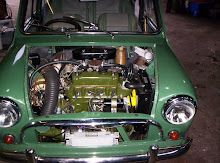This type of pump, shown in Figs. 32 and 33, is operated by a rocker arm which rests against a cam on the engine camshaft. When the arm is forced towards the pump it pulls a diaphragm downwards against spring pressure, drawing the petrol past the flange of a combined inlet and outlet valve. When the rocker arm moves in the opposite direction the spring raises the diaphragm and forces the petrol through the lips of the valve into the centre of the outlet cover of the pump, and so through the outlet pipe, to the carburettor.
When the float chamber is full the needle valve closes and the pressure that is built up in the pumping chamber above the diaphragm keeps the diaphragm in its lower position. The inner end of the rocker arm moves freely up and down in the slot in the diaphragm pull-rod and delivery ceases until petrol is drawn from the carburettor.
The pump requires no maintenance except for occasional cleaning of the filter, which can be removed after unscrewing the three screws which retain the outlet cover. Mop out any sediment which has accumulated in the base of the chamber beneath the filter. The scaling ring between the top cover and the pump body must be in good condition, since an air leak past the flange of the cover will put tho pump out of action. The three retaining screws must be tightened evenly to avoid distorting the cover.
As with the electrical pumps, a mechanical pump which gives trouble is best replaced by a service-exchange unit. If fuel starvation is suspected, first disconnect the carhiircllor-eiul of the fuel delivery pipe, place it in a suitable container and rotate ihe engine with the ignition switched off. Regular spurts of fuel should How from the pipe.
If fuel is beinf delivered, check the carburettor needle valve and needle seating. The needle may be ItUCk or the fuel passage obstructed.
If the fuel contains air bubbles, check the tightness of the delivery cover screws on the pump. The sealing ring must be in good condition, as mentioned earlier.
If the pump seems to be in order, there must be an air leak in the pipe from the fuel tank to the pump. If there is no fuel flow, and no air bubbles appear, the pump is probably faulty and should be replaced.
Thursday, 15 October 2009
The S.U. Mechanical Pump
Posted by Info Mini Cars at 04:34
Subscribe to:
Post Comments (Atom)


0 comments:
Post a Comment